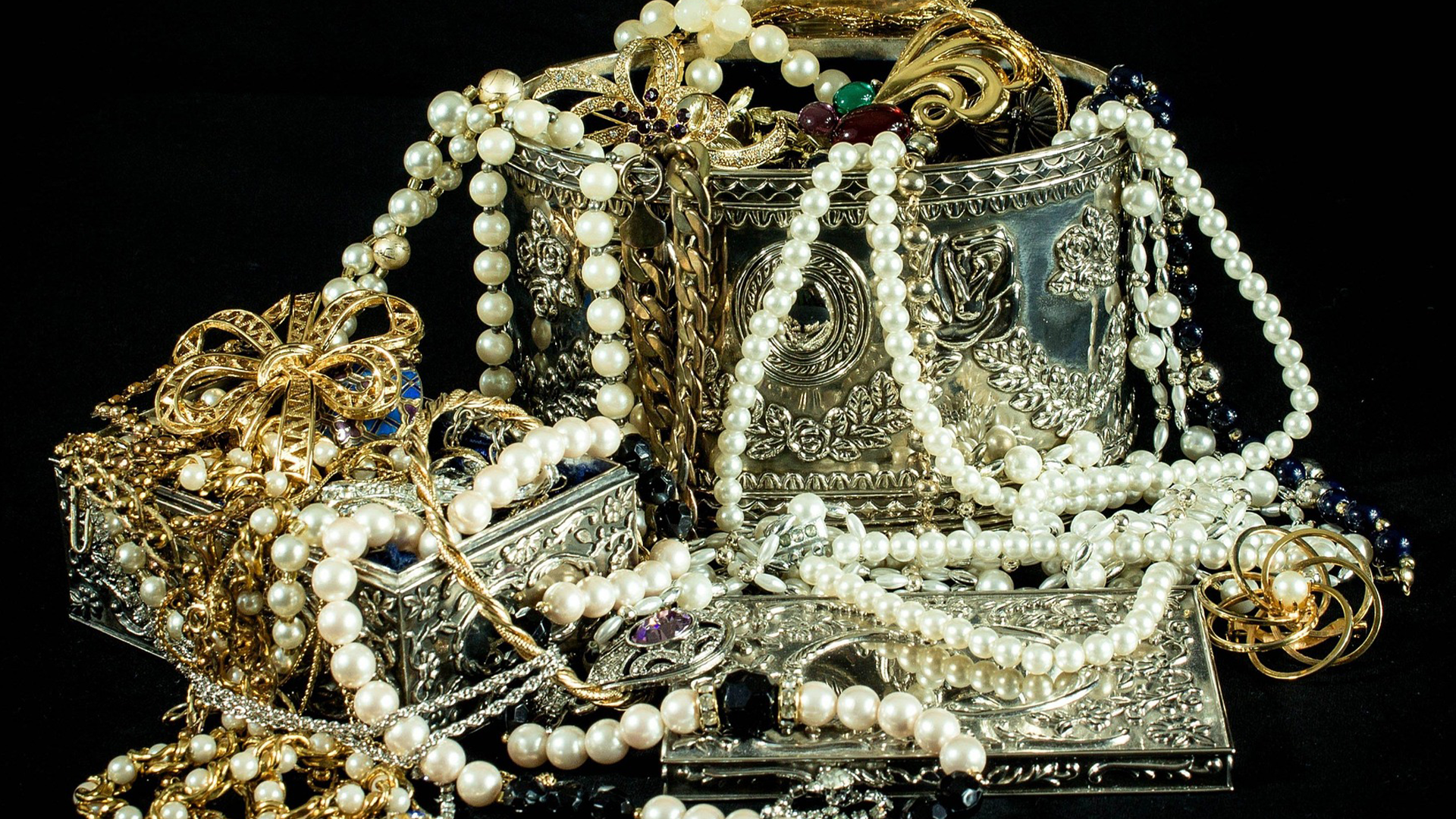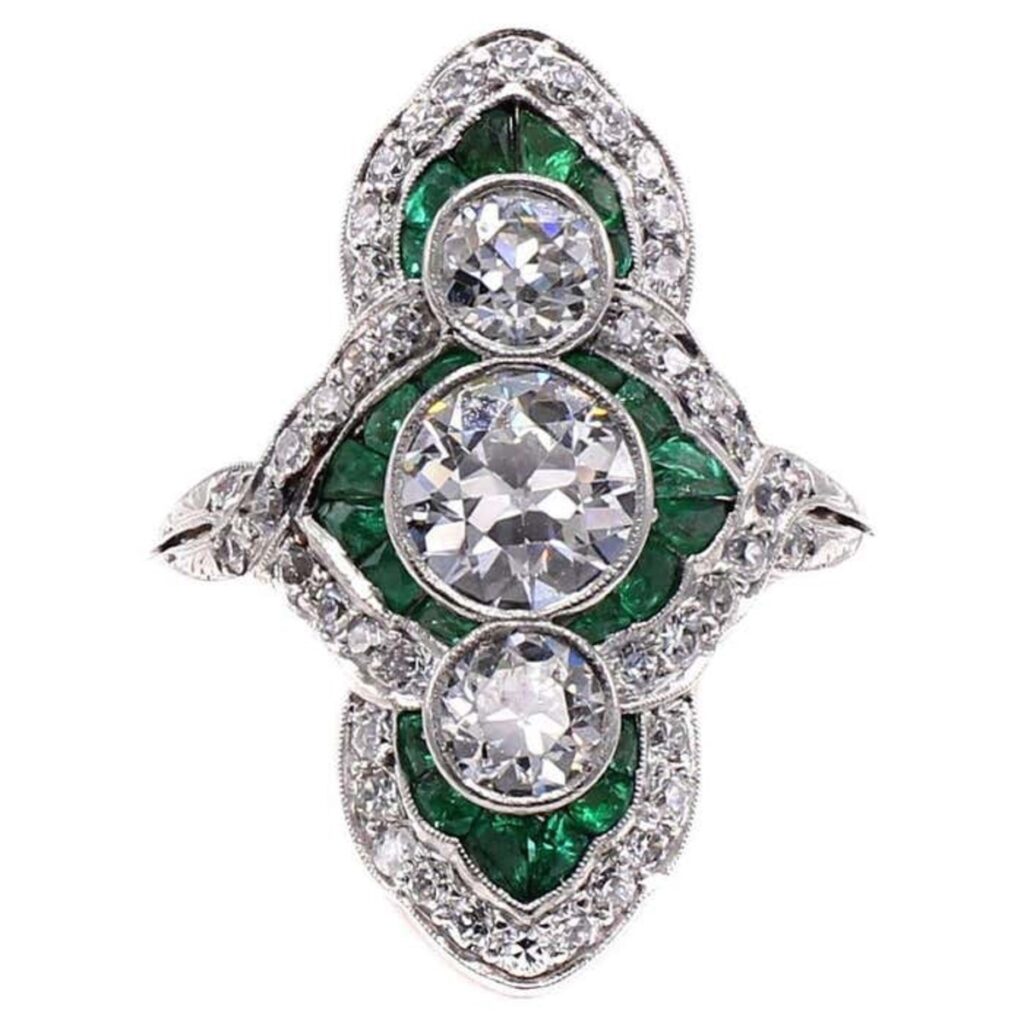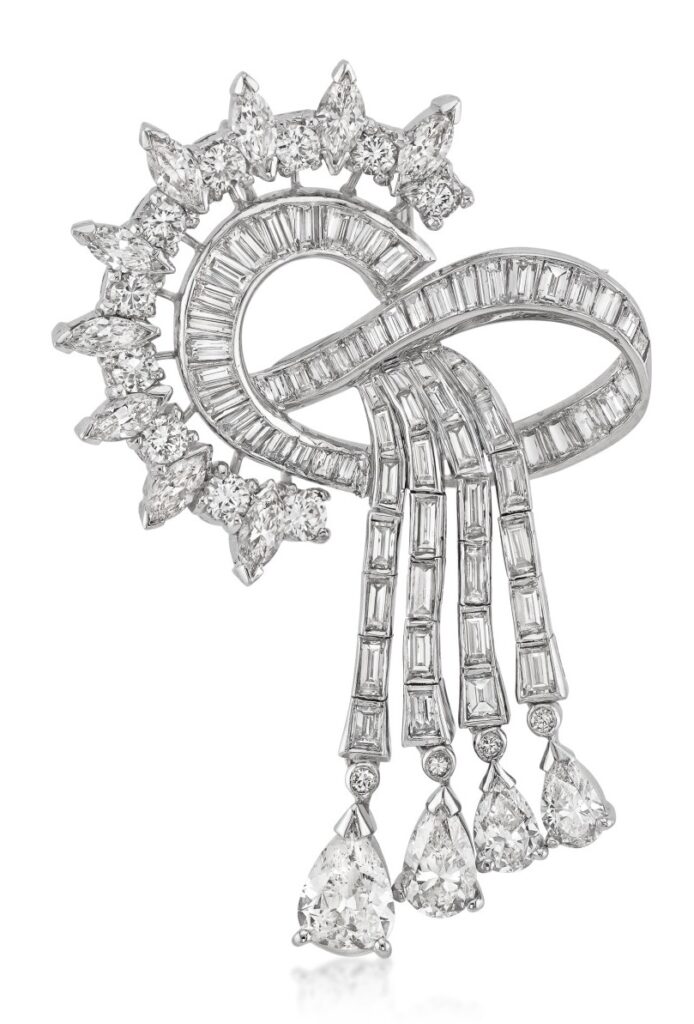Through the years, jewelry styles change, influenced by fashion, societal trends, micro- and macro-economic and technological innovations. Jewelry eras are generally connected either to a reigning monarch, or a decade, each with its own specific looks, motifs and trends. Here is a guide to some of the major jewelry design periods from the opulent Georgian era of the 1700s through the over-the-top 1980s.
Georgian Era Jewelry: Opulence
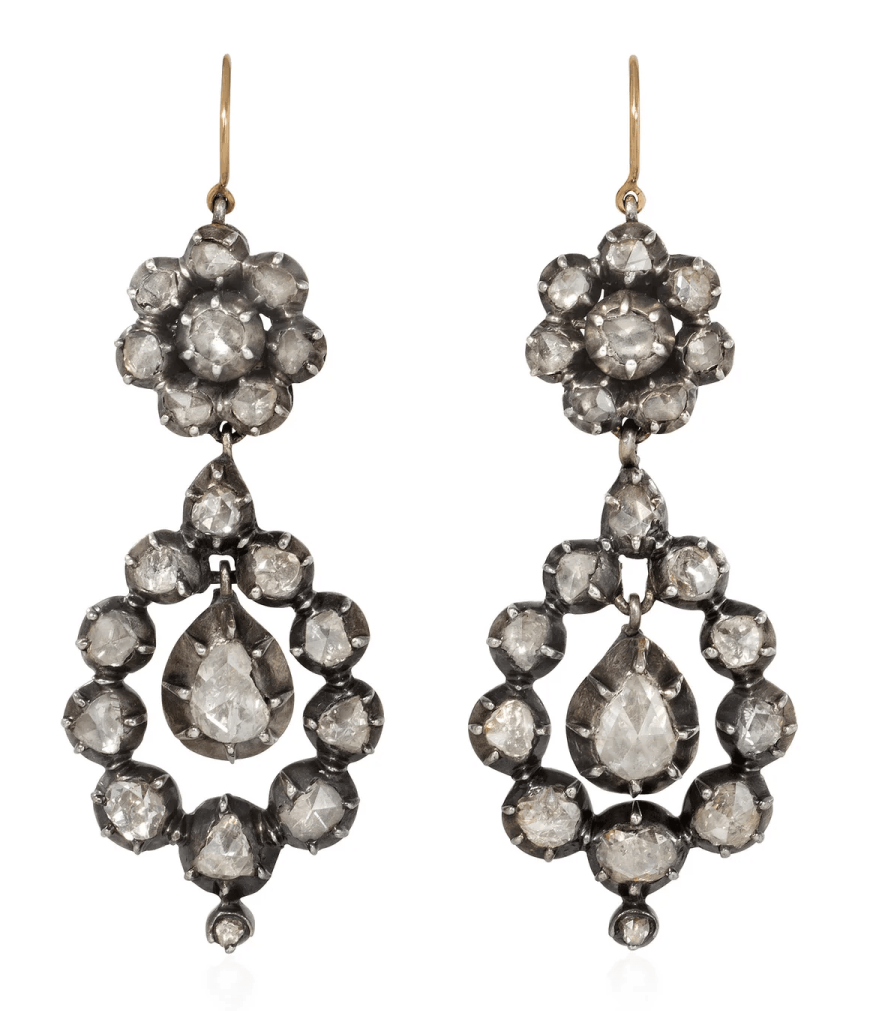
Influences: Culture, Art, Literature, Mozart, Jane Austen, Mary Shelley, Lord Byron, John Keats, Baroque, Rococo, French Revolution, Marie Antoinette, Napoleon Bonaparte, American Revolution, Regency England, Pompeii Excavation and Oversized Powdered Wigs all defined the Georgian era.
When: 1714-1837, the Georgian era covered most of the 1700s and the early years of the 1800s. The century is called the Georgian era because there were four King Georges (I-IV) during that time. King George IV died in 1830 and with no children as heirs to the title, his brother William IV ascended the throne. Most historians agree that the Georgian era ends when Victoria took over the throne in 1837, however some historians select 1830 as the end of the Georgian era as George IV was the last George of that time period. While much of Georgian jewelry is informed by British art and culture, the aesthetic was global.
Famous Makers: Jewelry was handcrafted during this time and with few exceptions there were generally no makers marks or gold marks used in this period.
Motifs: Early 1700s: Bows, Ribbons, Florals, Sprays of Foliage, Feathers, Crescent Moons, Crowns, Crosses, Hearts. Later 1700s: Arrows, Lyres, Intaglios, Geometric Forms, Pyramids, Papyrus Leaves, Roman and Greek Neoclassic Designs.
The Look: Parures, Hair Ornaments, Girandole Earrings, Pendoloque Earrings, Closed Back Settings, Enameling, Subdued for Daytime, Diamonds for Nighttime.
Materials: Table Cut, Rose Cut and Old Mine Diamonds, Ruby, Sapphire, Emerald, Garnet, Topaz, Coral, Shell, Agate, Chrysoberyl, Turquoise, Carnelian, Pearl, Ivory, Silver, Gold, Pinchbeck.
Victorian Era Jewelry: Sentimental
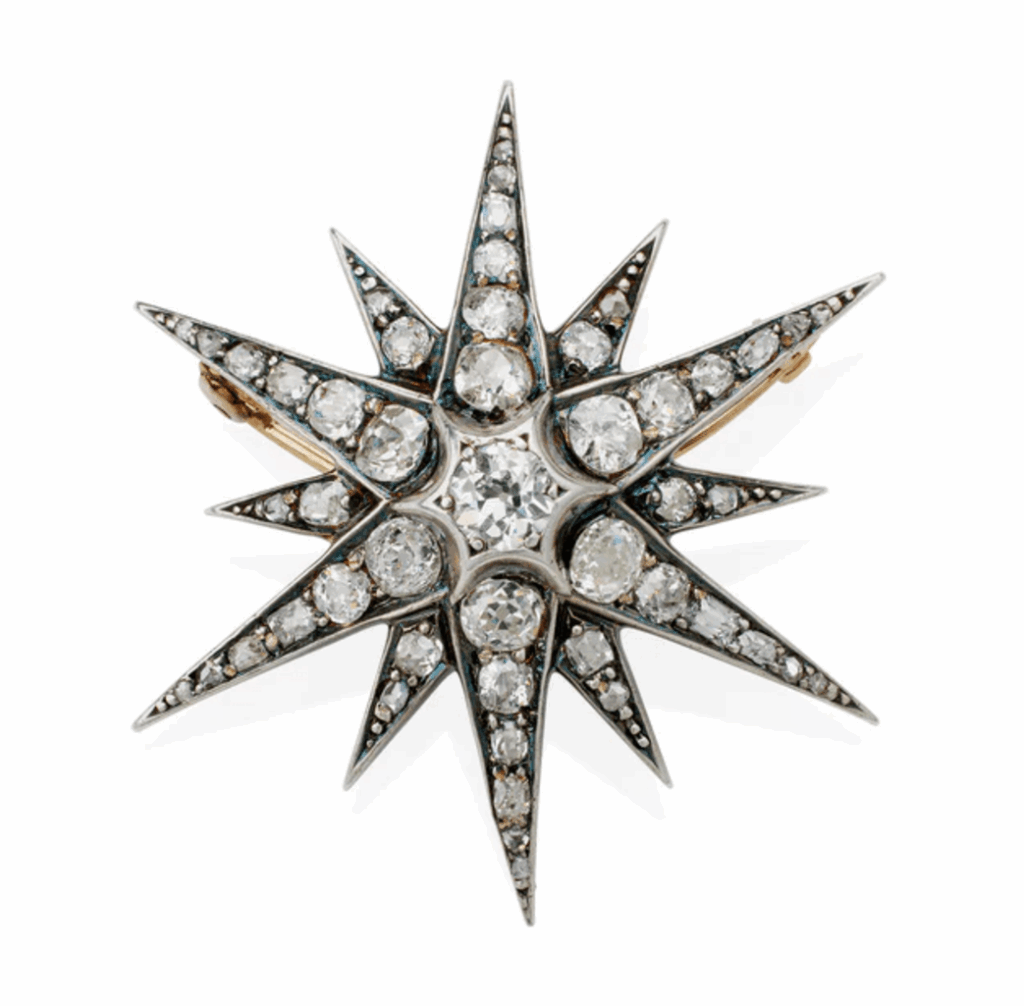
Influences: Queen Victoria Ascends the Throne, Queen Victoria Marries Prince Albert, Industrial Revolution Grows, Rising Middle Class, Charles Darwin and Charles Dickens defined the Romantic Years. Prince Albert dies, diamonds are discovered in South Africa, silver discovered in Nevada, archeological excavations, women enter the workforce in droves, suffragette movement begins, Suez Canal opens, opal discovered in Australia and Japonism were some of the events that defined the Grand Years. Electricity, Arts & Crafts Movement, Art Nouveau, Suffragette Movement, Gibson Girls, Art Workers Guild, Arts & Crafts Exhibition Society, Sarah Bernhardt all defined the Aesthetic Years.
When: 1837-1901. At just 18-years old, Victoria ascended the throne on June 20, 1837 and ruled for 63 years and 7 months before she died on January 21, 1901. Her reign was known as the Victorian era (Victoriana) and was subdivided into three periods, Romantic, Grand and Aesthetic, with each period triggered by major events. The Romantic Years, also known as the Early Years, run from 1837 to 1861, with some historians noting the dates to be 1837 to 1860. The Grand Years were from 1861 to 1885 and the Aesthetic Years covered 1885-1901. While the Victorian era was specifically British, Queen Victoria’s status and the reach of the British empire caused Victoriana to be a global influence. It is important to note that there were changes in jewelry styles during the 63 years that Victoria was on the throne. However, there were also certain motifs and themes that stayed throughout her reign. Styles did not drastically change as the years went by, instead they evolved over time. What that means is that you will see certain motifs or themes that will carry over from the different periods during Victoriana. This is often known as transitional jewelry.
Famous Makers: During the Romantic Years, makers were not generally named, however Mellerio, Boucheron and Garrard were named firms making jewelry. Queen Victoria appointed Garrard as the first Crown Jeweler supplying her with jewelry and caring for the crown jewels. Grand Years: Most makers were still not credited for their work during this time, but there were a number of important names creating jewelry — Mellerio, Boucheron, Köchert, Fontenay, Garrard, Giuliano, Castellani, Wiese, Froment-Meurice, Fontana, Robert Phillips, Faberge, Maseria, Verver, Froment-Meurice. Aesthetic Years: Mellerio, Boucheron, Köchert, Fontenay, Garrard, Giuliano, Castellani, Wiese, Froment-Meurice, Fontana, Robert Phillips, Faberge, Masriera, Verver, Froment-Meurice, Boivin, Tiffany & Co. More jewelers began signing their work during these years.
Motifs: Romantic Years: Snakes, Flowers, Vines, Leaves, Hearts, Bows, Birds, Knots, Eyes, Hands, Anchors, Crosses, Buckles, Grapes. Grand Years: Crescent Moon, Stars, Hearts, Bees, Birds, Acorns, Flowers, Ancient Greek, Roman and Etruscan themes, Buckles. Aesthetic Years: Sports themes, Hearts, Bows, Birds, Animal Heads, Horseshoes, Crescent Moons, Stars, Quatrefoils, Trefoils, Wishbones, Owls, Knots, Crowns.
The Look: Romantic Years: Ornate, decorated, colorful, large pieces, sentimental jewelry, anything with snakes. Grand Years: Etruscan, Egyptian and Roman revival, large pieces with color, mourning jewelry. Aesthetic Years: Jewelry became smaller during this time, there was a wide diversity of styles, lighter color gemstones and pastel enamels.
Materials: Romantic Years: 18-karat Yellow or Rose gold, Rolled Gold (a gold sheet soldered to base metal), Gold Electroplate (a very thin sheet of gold soldered to base metal), Pinchbeck, Aluminum, Cut Steel, Diamond, Emerald, Amethyst, Chalcedony, Garnet, Chrysoberyl, Turquoise, Malachite, Topaz, Seed Pearls, Tortoise Shell, Ivory and Coral. Grand Years: Gold in 9-, 12- and 15-karat, Rolled Gold, Silver, Steel, Enamel, Amethyst, Garnet, Diamond, Ruby, Sapphire, Opal, Pearl, Jet, Gutta Percha, Onyx. Aesthetic Years: Silver, Oxidized Silver, Gold, Rolled Gold, Platinum, Aquamarine, Amethyst, Diamond, Ruby, Emerald, Sapphire, Turquoise, Opal, Moonstone, Pearl, Peridot, Quartz, Chrysoberyl, Chrysoprase, Horn.
Edwardian Era Jewelry: Elegant
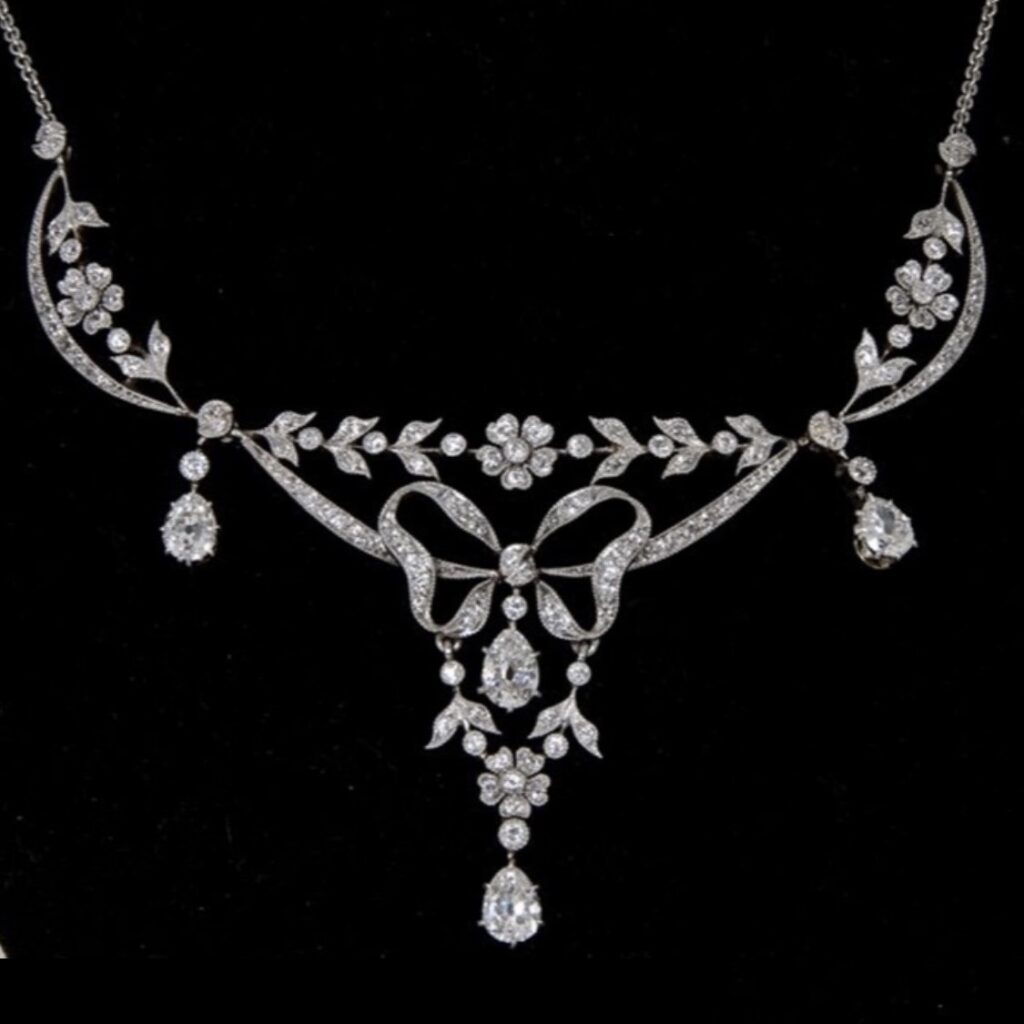
Influences: Opulent, Refined, Luxurious, Lifestyles of the Rich and Royal, White, Platinum, Pearls, Diamonds all defined the Edwardian era.
When: 1901 -1915, the Edwardian era officially began during the reign of King Edward VII in 1901 (although he was coronated in 1902) and ended with the start of World War I in 1914/1915, historians vary as to the exact dates. Edward, the son of Queen Victoria, began to take on many official duties after Prince Albert, the Queen’s husband and Edward’s father, died. The Edwardian style began to develop in the late 1800s and blossomed during his reign. Even though this same time period was known as the Belle Epoque in other parts of Europe and as the Gilded Age in the United States, the jewelry had the same design aesthetic.
Famous Makers: Boucheron, Cartier, Chaumet, Fabergé, Garrads, LaCloche, Tiffany & Co., Marcus & Co., J.E. Caldwell.
Motifs: Bows, Ribbons, Garlands, Laurel Wreaths, Florals, Feathers and Tassels, Stars, Millegrain.
The Look: White-on-white platinum with pearls and/or diamonds, light and lacy, intricate, formal and regal.
Materials: Platinum, Pearls, Diamonds, Pink Topaz, Peridot, Demantoid Garnet, Amethyst, Turquoise, Blue Sapphire, Ruby, Emerald, Aquamarine, Kunzite, Opal, Moonstone and Alexandrite.
Art Deco Era: Glamorous
Influences: The Jazz Age, The Charleston, Flappers, Tutankhamun, Cubism, Graphic Design, Airplanes, Automobiles, Industrialism, Russe Ballet, “Exposition Internationale des Arts Décoratifs et Industrials Modernes”, Prohibition, Cocktails and Speakeasies defined the Art Deco era.
When: Art Deco, which encompasses all the decorative arts including jewelry was from 1920 to 1939. It began to manifest a couple of years before World War I and took off when the war ended, building and evolving until World War II came along. Some jewelry historians refer to 1930s Art Deco as Art Moderne or Modernism. The era is also known as the “style between the wars”. Art Deco was fully launched in 1925 at the Paris “Exposition Internationale des Arts Decoratifs et Industrials Modernes” where this new look was on full display.
Famous Makers: Boucheron, Black Starr & Frost, Cartier, Chaumet, Jean Deprès, Georges & Jean Fouquet, Lalique, LaCloche, Mauboussin, Raymond Templier, Tiffany & Co., Van Cleef & Arpels, Raymond Yard all signed their work.
Motifs: Egyptian, Asian, African and Native American Art, Geometric Forms, Flora and Fauna, Architecture, Tassels.
The Look: 1920s Art Deco: Flat, Linear, Symmetrical, Geometric, White on White, Black and White, Bold Color, Long Necklaces. 1930s Art Deco: Bigger, Wider Bracelets; Convertible Jewelry, Rounded Scrolling Forms, Bib and Collar Necklaces.
Materials: Diamonds, Rubies, Sapphires, Emeralds, Rock Crystal, Onyx, Lapis, Coral, Pearls, Carved Gems, Cabochon Gems, Enamel, Lacquer, Platinum, White Gold, Yellow Gold.
1940s Retro Jewelry: Patriotic
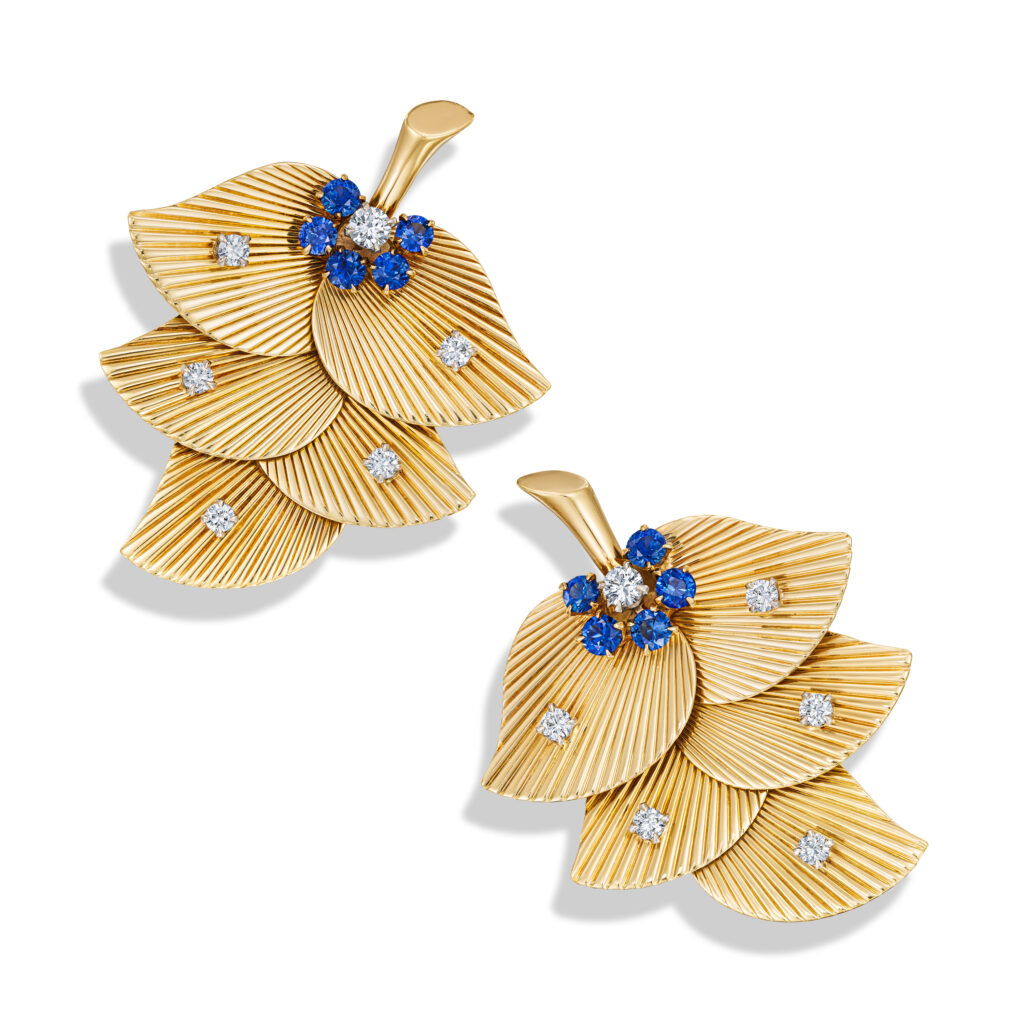
Influences: WWII, Pearl Harbor, Rosie the Riveter, USO, Rationing, Women’s Army Corps, Great Depression Ends, Housing Boom, Baby Boom, Jackie Robinson, Color Television, Big Band Music, Swing Era, Zoot Suits and Bikinis all defined the 1940s.
When: 1940-1949, the first half of the decade was all about the war effort, which ended the Great Depression. The second half of the decade was about recovering from the war, a time when the economy began to boom, with houses and babies, top priorities of this newly prosperous time.
Famous Makers: Boucheron, Boivin, Cartier, Marchak, Mellirio, Sterle , Tiffany & Co., Traebert and Hoeffer Mauboussin, Van Cleef & Arpels, Raymond Yard.
Motifs: Red, White and Blue, Patriotic Themes, Flags, Airplanes, Eagles, Bows, Tank Tire Treads, Flowers, Animals, Birds, Hearts, V for Victory, Ballerinas.
The Look: Oversized jewelry, large colored gemstones set in yellow or rose gold, small stones used to create big pieces, scrolling forms, fan shapes.
Materials: Topaz, Citrine, Amethyst, Aquamarine, Rubies, Sapphires, Diamonds, Rose Gold.
1950s Jewelry: Formal
Influences: The Boom Years, Atomic Age, Cold War, The Red Scare, Suburbia, Consumerism, Uniformity, Cultural Conformity, Civil Rights Movement Was Born, Rock ‘n’ Roll, Elvis Presley, Television, Abstract Expressionism all defined the 1950s.
When: 1950-1959. The 1950s was an era of unprecedented prosperity in the United States. The war was over, people had come home from overseas and life was much more joyous and lighthearted. The 1950s were boom years, a housing boom and a baby boom were well underway.
Famous Makers: Boivin, Boucheron, Buccellati, Bulgari, Cartier, Chaumet, Marchak, Mellerio, Sterle, Tiffany & Co., Van Cleef & Arpels, Harry Winston.
Motifs: Naturalistic Themes, Flowers, Leaves, Animals, Fish, Birds, Spirals, Clusters, Disks, Bows, Ribbons, Tassels.
The Look: Matching Sets of Jewelry, Big, Colorful, Textured Gold, Diamonds, Platinum, Simple Pearl Strands, Formal.
Materials: Textured Gold, Platinum, Diamonds, Colored Gemstones, Pearls, Fancy Shaped Diamonds.
1960s Jewelry: Mod
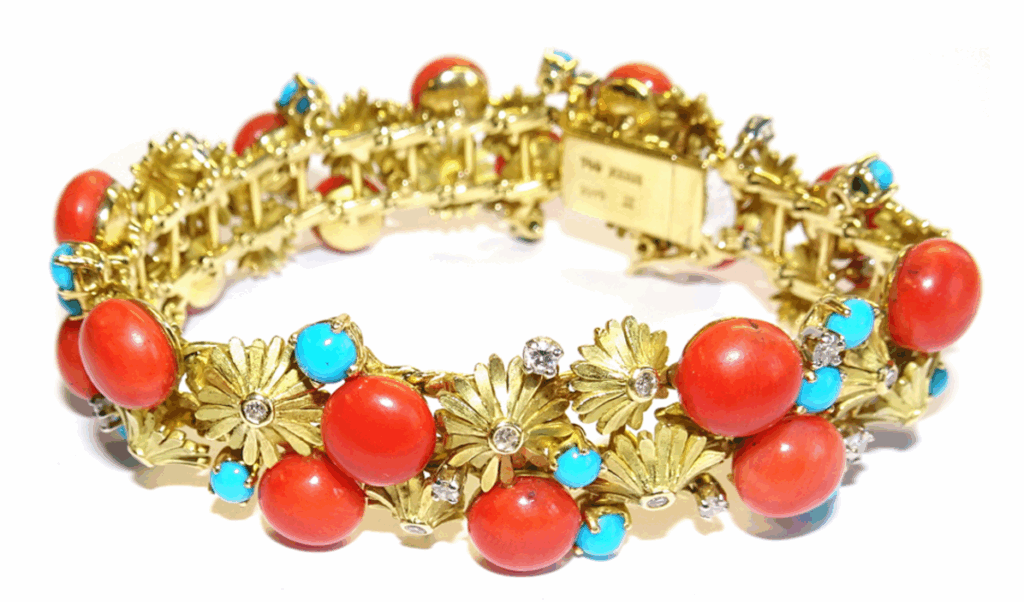
Influences: Organic Shapes, Abstract Forms, Mod, Pop Art, Hippies, The Great Society, Space Age, The Beatles and tremendous social change all defined the 1960s.
When: 1960 to 1969. At the start of the 1960s John F. Kennedy had just been elected President, the look of the time was put together and ladylike with gloves, pillbox hats and a prim strand of pearls accessorizing a simple sheath dress or suit. By the end of the 1960s, hippies were taking to the streets to protest the Vietnam war. Bright colors, bold color blocking, miniskirts and go-go boots were of the moment and the bohemian look began to take hold as styles became more casual and free from the strict rules of earlier decades.
Famous Makers: Cartier, John Donald, Andrew Grima, Jean Schulmberger for Tiffany & Co., Van Cleef & Arpels, David Webb, Harry Winston, Rene Kern.
Motifs: Textured Gold, Space Age Influences, Flaming Stars, Animals, Birds, Flowers, Angular Shapes, Architectural, Asymmetrical.
The Look: Textured yellow gold with bold color combinations, abstract, large-scale, chic and playful. Starbursts, sunbursts and other “space” themes. Cluster rings were popular with a large stone resting on top of a cluster of stones – often diamonds. Ballerina settings were also a favorite with a large center stone surrounded by diamonds — frequently baguettes — that appear to float like a dancer’s tutu, around the central gem.
Materials: Yellow Gold, Silver, Turquoise, Coral, Sapphires, Rubies, Emeralds, Pear and Marquise Diamond Shapes, Cabochon Cut Gems, Baroque Pearls, Lapis and Other Hardstones, Sometimes Carved.
1970s Jewelry: Swinging
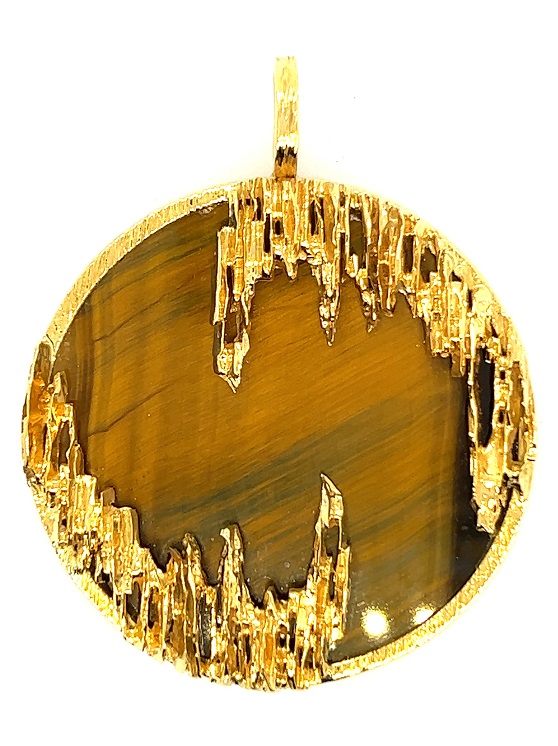
Influences: Bohemian, The Me Decade, Jet Set, Women’s Rights, Watergate, Eastern Influences, Ethnic, Oversized, Bell Bottoms, Disco, Environmentalism, Earth Day all defined the 1970s.
When: 1970 – 1979. The 1970s started out with the Vietnam war at the forefront of the news as protesters continued to fill the streets with antiwar demonstrations. The war ended in the mid 1970s. As the decade progressed disco hustled in to take over clubs and music radio spawning a whole new fashion story and cultural touchpoint.
Famous Makers: Bulgari, Cartier, Chaumet, David Morris, David Webb, Fred, Kutchinsky, Elsa Peretti for Tiffany & Co., Van Cleef & Arpels.
Motifs: Florals, Zodiacs, Fanciful Animals, Abstract Forms, Bold Color, Geometric, Medallions, Big Link Chains, Ancient Coins.
The Look: Statement Pieces, Textured Gold, Sleek Silver, Chunky, Colorful, Layered, Multicultural.
Materials: Yellow Gold, Silver, Lapis and Other Hardstones, Wood or Shell Combined with Gems or Gold, Fancy Shaped Diamonds, Antique Coins.
1980s Jewelry: Big

Influences: Reaganomics, New Conservatism, Wall Street, Yuppies, Preppies, Cable TV, MTV, Rap, Punk Rock, New Wave, New Age, Iran-Contra, Logomania, Princess Diana and anything big all defined the 1980s.
When: 1980-1989 The 1980s was a time of contrasts and individuality. It was a decade of big: Big hair, big shoulders, big money. Wall street was creating unprecedented wealth while CEO’s received huge paychecks. Young urban professionals knowns as “Yuppies”, who were educated with upwardly mobile jobs had money to spend and they did so lavishly. Cable TV was introduced and MTV brought music and fashion into our living rooms. The influence of music on fashion was huge as Cindy Lauper and Madonna flounced around in corsets and petticoats making underwear as outwear subversively chic. Women were on the rise professionally, taking on c-suite jobs and for the first time, the number of women enrolled in college outnumbered men.
Famous Makers: Marina B., Henry Dunay, Barry Kieselstein-Cord, Paloma Picasso, Bulgari, Elizabeth Gage, Elizabeth Locke, Cartier, Tiffany & Co., Van Cleef & Arpels.
Motifs: Florals, Geometrics, Triangles, Rectangles, Stars, Oversized, Cabochons, Textured Metals, Panthers, Reptiles, Invisible Settings.
The Look: Big, Colorful and Over-the-Top Opulence, Bold Gold, Diamond Pavé, Mixed Metals, Square Shaped Diamonds, Dramatic, Big Hoops, Big Earrings, Chain Link Necklaces and Bracelets, Tennis Bracelet, Stacking Rings, Brooches, Chokers.
Materials: Pearls, Sapphires in all colors, especially blue, Garnet, Tourmaline, Amethyst, Citrine, Blue Topaz, Tanzanite, Gold, Silver, Platinum.
Top of Page: Photo courtesy James DeMers, Pixabay.
Authored by Amber Michelle
